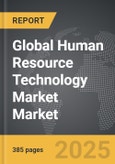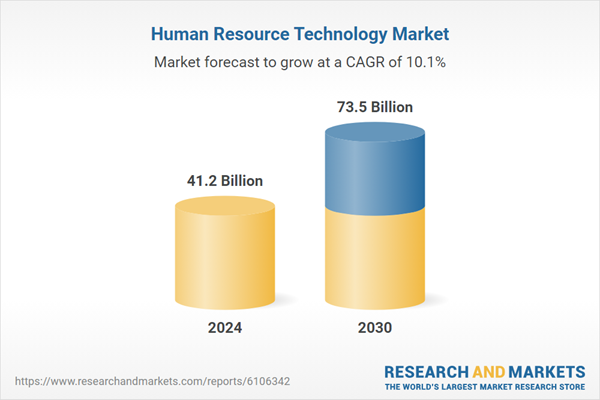Global Human Resource Technology Market - Key Trends & Drivers Summarized
How Are Changing Workplace Dynamics Influencing the Evolution of Human Resource Technology?
Human resource technology is evolving rapidly as organizations face dramatic shifts in how, where, and why work is done. Traditional office-based operations are being replaced by flexible, hybrid, and remote work environments, which demand digital systems that can manage employee experiences from anywhere. This change has intensified the need for HR platforms that are agile, data-rich, and user-centric. Businesses now rely on HR technology not only to streamline administrative processes but also to foster connectivity, manage distributed teams, and drive engagement in a more virtual world. Tools for performance tracking, virtual onboarding, and remote learning have become essential components of modern HR operations. Furthermore, employee expectations are shifting, with workers demanding more transparency, real-time feedback, and autonomy in managing their career paths. HR technologies are being designed to meet these expectations through mobile apps, chat-based communication, and personalized interfaces that allow employees to interact with HR functions on their terms. This evolution is not merely about replacing paperwork with digital files, but about transforming the entire employee lifecycle into a cohesive, seamless experience. From recruitment and onboarding to learning, payroll, and succession planning, HR platforms now serve as integrated ecosystems that support continuous interaction and decision-making. In this dynamic environment, human resource technology is emerging as a core strategic function that links workforce performance directly to business success.Why Are Automation and Artificial Intelligence Redefining Talent Management Through HR Tech?
Automation and artificial intelligence are reshaping the landscape of talent management by streamlining complex processes and enhancing decision-making through data-driven insights. Automated systems have reduced the burden of repetitive HR tasks such as benefits administration, timesheet tracking, and resume screening, freeing up HR professionals to focus on higher-level strategy and employee engagement. Meanwhile, AI is enabling deeper analysis of candidate profiles, matching applicants with roles not only based on skills but also on behavioral patterns and cultural fit. This smart filtering improves recruitment accuracy, reduces bias, and accelerates hiring cycles. In performance management, machine learning algorithms can identify trends, flag potential disengagement, and suggest timely interventions that support employee well-being and retention. Learning and development systems powered by AI are now offering adaptive learning paths tailored to each individual's progress and role requirements, ensuring training is both efficient and relevant. Predictive analytics is also gaining traction in succession planning and workforce forecasting, helping companies prepare for talent gaps before they arise. Chatbots and virtual HR assistants are handling routine employee queries, reducing wait times and enhancing internal service levels. These innovations are transforming HR from a transactional function into a proactive partner in business growth. As organizations become more data-centric, the ability of HR technology to deliver precise, real-time intelligence becomes a powerful asset in attracting, nurturing, and retaining top talent.How Is Integration and Employee Experience Driving Demand for Unified HR Platforms?
The growing emphasis on seamless user experience and unified data systems is driving strong demand for integrated HR technology platforms. Rather than using a patchwork of disconnected software tools, companies are adopting end-to-end solutions that cover recruitment, onboarding, payroll, benefits, learning, and performance in a single ecosystem. This approach not only reduces data duplication and administrative effort but also improves the employee journey by providing a consistent and intuitive interface across all HR touchpoints. Modern workers expect the same level of digital convenience in the workplace as they do in their personal lives, making user-friendly design and mobile compatibility critical features of successful HR systems. Unified platforms also support better data visibility for leadership, enabling HR departments to generate comprehensive reports and strategic insights from a central dashboard. Integration with other enterprise systems such as finance, IT, and operations allows for real-time updates and cross-functional alignment. Companies with global operations especially benefit from platforms that support multi-language, multi-currency, and region-specific compliance needs, ensuring consistent employee experiences regardless of location. These systems also play a key role in culture-building and engagement, offering tools for social recognition, peer feedback, and internal mobility that strengthen organizational cohesion. By eliminating silos and enabling holistic workforce management, integrated HR technology not only enhances operational efficiency but also positions HR as a strategic enabler of long-term organizational resilience and adaptability.What Are the Primary Drivers Behind the Global Growth of the Human Resource Technology Market?
The expansion of the human resource technology market is driven by a convergence of demographic trends, business needs, and technological advancement. One of the leading factors is the changing composition of the global workforce, with younger, digitally native employees expecting real-time access to HR services and meaningful career development opportunities. As businesses compete to attract and retain top talent, investment in modern HR solutions has become a priority. Another significant driver is the increasing complexity of labor laws, workplace compliance, and reporting obligations, particularly in multinational organizations. HR technologies that automate compliance monitoring and generate audit-ready documentation are helping businesses navigate this complexity more efficiently. The rise of remote and hybrid work models has further amplified the need for cloud-based solutions that allow for location-independent access and collaboration. Additionally, companies are placing a greater focus on employee well-being, diversity, and inclusion, all of which are supported by analytics-driven HR platforms that can measure engagement and monitor equity. Venture capital interest in HR tech startups is another signal of market vitality, leading to a proliferation of niche platforms addressing specific needs such as mental health, mentoring, and gig workforce management. Subscription-based models and scalable cloud architectures have lowered the barrier to entry, making advanced HR technology accessible even to small and mid-sized enterprises. As the global economy becomes more knowledge-driven, the ability to manage human capital through sophisticated digital tools is emerging as a key differentiator, ensuring that the HR technology market will continue to grow in size, sophistication, and strategic relevance.Report Scope
The report analyzes the Human Resource Technology market, presented in terms of market value (US$). The analysis covers the key segments and geographic regions outlined below:- Segments: Deployment (Cloud Deployment, On-Premise Deployment); Application (Payroll Management Application, Talent Management Application, Workforce Management Application, Recruitment Application); Other Applications); End-Use (Telecom & IT End-Use, BFSI End-Use, Retail End-Use, Healthcare End-Use, Government End-Use, Other End-Uses).
- Geographic Regions/Countries: World; United States; Canada; Japan; China; Europe (France; Germany; Italy; United Kingdom; Spain; Russia; and Rest of Europe); Asia-Pacific (Australia; India; South Korea; and Rest of Asia-Pacific); Latin America (Argentina; Brazil; Mexico; and Rest of Latin America); Middle East (Iran; Israel; Saudi Arabia; United Arab Emirates; and Rest of Middle East); and Africa.
Key Insights:
- Market Growth: Understand the significant growth trajectory of the Cloud Deployment segment, which is expected to reach US$49.1 Billion by 2030 with a CAGR of a 11.4%. The On-Premise Deployment segment is also set to grow at 7.8% CAGR over the analysis period.
- Regional Analysis: Gain insights into the U.S. market, valued at $11.2 Billion in 2024, and China, forecasted to grow at an impressive 14% CAGR to reach $15.2 Billion by 2030. Discover growth trends in other key regions, including Japan, Canada, Germany, and the Asia-Pacific.
Why You Should Buy This Report:
- Detailed Market Analysis: Access a thorough analysis of the Global Human Resource Technology Market, covering all major geographic regions and market segments.
- Competitive Insights: Get an overview of the competitive landscape, including the market presence of major players across different geographies.
- Future Trends and Drivers: Understand the key trends and drivers shaping the future of the Global Human Resource Technology Market.
- Actionable Insights: Benefit from actionable insights that can help you identify new revenue opportunities and make strategic business decisions.
Key Questions Answered:
- How is the Global Human Resource Technology Market expected to evolve by 2030?
- What are the main drivers and restraints affecting the market?
- Which market segments will grow the most over the forecast period?
- How will market shares for different regions and segments change by 2030?
- Who are the leading players in the market, and what are their prospects?
Report Features:
- Comprehensive Market Data: Independent analysis of annual sales and market forecasts in US$ Million from 2024 to 2030.
- In-Depth Regional Analysis: Detailed insights into key markets, including the U.S., China, Japan, Canada, Europe, Asia-Pacific, Latin America, Middle East, and Africa.
- Company Profiles: Coverage of players such as Abbott Laboratories, Access Bio, Inc., ACON Laboratories, Inc., Alere Inc. (now Abbott Rapid Dx), Atlas Medical and more.
- Complimentary Updates: Receive free report updates for one year to keep you informed of the latest market developments.
Some of the 43 companies featured in this Human Resource Technology market report include:
- ADP, Inc.
- BambooHR
- Betterworks
- Ceridian HCM Holding Inc.
- Cornerstone OnDemand
- Darwinbox
- Deel Inc.
- Eightfold AI
- Gusto
- HiBob
- iCIMS
- Jobvite
- Kronos Incorporated (UKG)
- Namely
- Oracle Corporation (HCM)
- Paychex, Inc.
- Paycom Software, Inc.
- SAP SuccessFactors
- TriNet Group, Inc.
- Workday, Inc.
This edition integrates the latest global trade and economic shifts into comprehensive market analysis. Key updates include:
- Tariff and Trade Impact: Insights into global tariff negotiations across 180+ countries, with analysis of supply chain turbulence, sourcing disruptions, and geographic realignment. Special focus on 2025 as a pivotal year for trade tensions, including updated perspectives on the Trump-era tariffs.
- Adjusted Forecasts and Analytics: Revised global and regional market forecasts through 2030, incorporating tariff effects, economic uncertainty, and structural changes in globalization. Includes historical analysis from 2015 to 2023.
- Strategic Market Dynamics: Evaluation of revised market prospects, regional outlooks, and key economic indicators such as population and urbanization trends.
- Innovation & Technology Trends: Latest developments in product and process innovation, emerging technologies, and key industry drivers shaping the competitive landscape.
- Competitive Intelligence: Updated global market share estimates for 2025, competitive positioning of major players (Strong/Active/Niche/Trivial), and refined focus on leading global brands and core players.
- Expert Insight & Commentary: Strategic analysis from economists, trade experts, and domain specialists to contextualize market shifts and identify emerging opportunities.
Table of Contents
Companies Mentioned (Partial List)
A selection of companies mentioned in this report includes, but is not limited to:
- ADP, Inc.
- BambooHR
- Betterworks
- Ceridian HCM Holding Inc.
- Cornerstone OnDemand
- Darwinbox
- Deel Inc.
- Eightfold AI
- Gusto
- HiBob
- iCIMS
- Jobvite
- Kronos Incorporated (UKG)
- Namely
- Oracle Corporation (HCM)
- Paychex, Inc.
- Paycom Software, Inc.
- SAP SuccessFactors
- TriNet Group, Inc.
- Workday, Inc.
Table Information
| Report Attribute | Details |
|---|---|
| No. of Pages | 385 |
| Published | December 2025 |
| Forecast Period | 2024 - 2030 |
| Estimated Market Value ( USD | $ 41.2 Billion |
| Forecasted Market Value ( USD | $ 73.5 Billion |
| Compound Annual Growth Rate | 10.1% |
| Regions Covered | Global |









